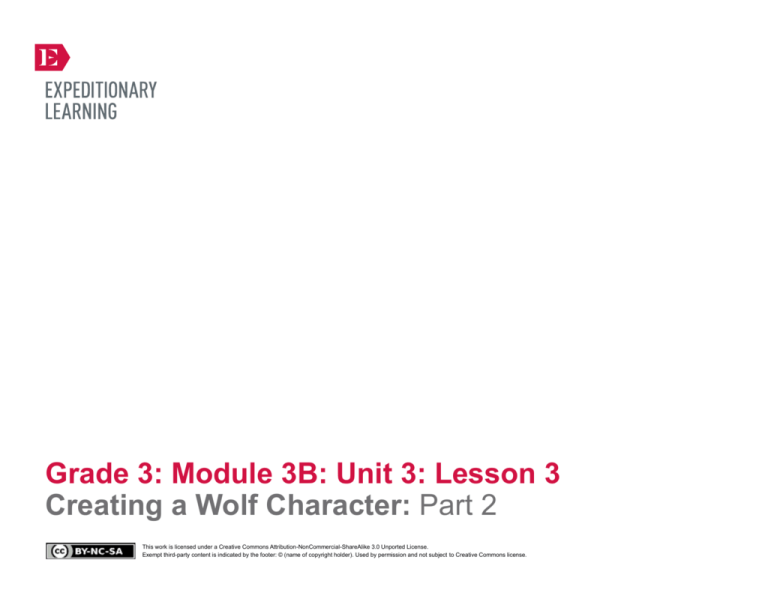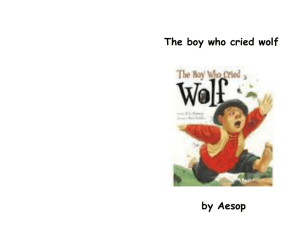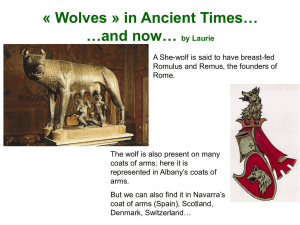
Grade 3: Module 3B: Unit 3: Lesson 3
Creating a Wolf Character: Part 2
This work is licensed under a Creative Commons Attribution-NonCommercial-ShareAlike 3.0 Unported License.
Exempt third-party content is indicated by the footer: © (name of copyright holder). Used by permission and not subject to Creative Commons license.
GRADE 3: MODULE 3B: UNIT 3: LESSON 3
Creating a Wolf Character:
Part 2
Long-Term Targets Addressed (Based on NYSP12 ELA CCLS)
I can craft narrative texts about real or imagined experiences or events. (W.3.3)
a. I can introduce the narrator and/or characters of my narrative.
Supporting Learning Target
Ongoing Assessment
• I can plan the character traits, special abilities, strengths, and weaknesses of the main wolf character in
my Wolf Narrative.
• Wolf Character Profile graphic organizer: Part 2
Created by Expeditionary Learning, on behalf of Public Consulting Group, Inc.
© Public Consulting Group, Inc., with a perpetual license granted to Expeditionary Learning Outward Bound, Inc.
NYS Common Core ELA Curriculum • G3:M3B:U3:L3 • June 2014 • 1
GRADE 3: MODULE 3B: UNIT 3: LESSON 3
Creating a Wolf Character:
Part 2
Agenda
Teaching Notes
1. Opening
• In this lesson, students plan the character traits of their wolf characters and begin to think about the
rest of their wolf packs.
A. Sharing Homework and Unpacking Learning
Targets (10 minutes)
2. Work Time
A. Character Profile: Part 2 (20 minutes)
B. Character Profile: The Wolf Pack (20 minutes)
3. Closing and Assessment
A. Partner Share (10 minutes)
4. Homework
A. Continue reading your independent reading book.
• As in the previous lesson, students analyze the Wolf Narrative model and provide feedback whole group
while the teacher models filling in the Wolf Character Profile graphic organizer: Part 2 with students’
responses.
• In analyzing the Wolf Narrative model, students will have to infer a lot of the character traits, as they are
not called out directly. Explain to students that authors build character profiles before they write so they
understand how their characters will respond in certain situations, not necessarily to call out those traits
directly.
• Students may find the facts and details recorded on the Who is the Wolf in Fact? anchor chart in Unit 2
useful here to determine the special abilities, strengths, and weaknesses a wolf has, but make it clear
that students will have to be more creative when they are planning their main wolf character’s traits.
Explain that in fictional narratives, we imagine that we know what wolves are thinking and feeling. We
don’t actually know how wolves think and feel, so we have to make that up and we base this on the only
thing we know, which is how humans think and feel. We use fiction to explain some of their behavior
because we don’t really know why they do things.
• In advance:
– Post: Learning target.
Created by Expeditionary Learning, on behalf of Public Consulting Group, Inc.
© Public Consulting Group, Inc., with a perpetual license granted to Expeditionary Learning Outward Bound, Inc.
NYS Common Core ELA Curriculum • G3:M3B:U3:L3 • June 2014 • 2
GRADE 3: MODULE 3B: UNIT 3: LESSON 3
Creating a Wolf Character:
Part 2
Lesson Vocabulary
Materials
• Wolf Character Profile graphic organizer: Part 1 (from Lesson 2; one per student)
• Wolf Character Profile graphic organizer: Part 2 (one per student and one to display)
• Colored pencils (four different colors per student)
• Wolf Narrative model (from Unit 2, Lesson 1; one per student)
• Wolf Character Profile graphic organizer: Part 2 (answers, for teacher reference)
• Who is the Wolf in Fact? (from Unit 2)
• Face to Face with Wolves (book; one per student)
Opening
Meeting Students’ Needs
A. Sharing Homework and Unpacking Learning Targets (10 minutes)
• Focus whole group and ask:
• Asking students to share their
homework makes them accountable
for doing it and gives you the
opportunity to determine who is not
completing their homework. It also
helps set up the thinking for the rest
of the lesson.
* “Which facts and details did you use from your research in Unit 2 to draw and label your wolf?”
• Invite students to retrieve their Wolf Character Profile graphic organizer: Part 1 and give them a couple of minutes
to think about their answers.
• Pair students up and invite them to share the labeled pictures they drew for homework with each other.
• Direct students’ attention to the posted learning target and read it aloud:
* “I can plan the character traits, special abilities, strengths, and weaknesses of the main wolf character in my Wolf
Narrative.”
• Remind students that in the previous lesson they used facts and details to create the appearance of their wolf. Tell them that
in this lesson they are going to plan the character traits, special abilities, strengths, and weaknesses of their main wolf
character.
Created by Expeditionary Learning, on behalf of Public Consulting Group, Inc.
© Public Consulting Group, Inc., with a perpetual license granted to Expeditionary Learning Outward Bound, Inc.
• Posting learning targets allows
students to reference them
throughout the lesson to check their
understanding. The learning targets
also provide a reminder to students
and teachers about the intended
learning behind a given lesson or
activity.
NYS Common Core ELA Curriculum • G3:M3B:U3:L3 • June 2014 • 3
GRADE 3: MODULE 3B: UNIT 3: LESSON 3
Creating a Wolf Character:
Part 2
Work Time
Meeting Students’ Needs
A. Character Profile: Part 2 (20 minutes)
• Distribute and display the Wolf Character Profile graphic organizer: Part 2.
• Modeling how to fill in the graphic
organizer will ensure that all
students know what is expected of
their work when they have to fill it
in themselves.
• Distribute three different colored pencils to each student.
• Invite students to read along silently as you read each section of the graphic organizer aloud.
• Encourage students to ask questions about anything they don’t understand.
• Explain that students are going to use this Part 2 organizer to finish planning their main wolf characters and begin planning
other characters in their narratives.
• Tell students that the Character Traits column will give them a chance to plan what their wolf is going to be like—the
personality it will have and the behavior and actions it demonstrates. Provide some examples: “He might be an angry wolf
who gets into trouble with the alpha male because he loses his temper with the other wolves; he might be a kind wolf who
always looks after the old, sick, and injured wolves in the pack; or she might be a very clever wolf who is able to solve
problems quickly.”
• Direct students to take out their Wolf Narrative model. Reread the model aloud as students follow along silently.
• Invite students to work in pairs to identify the details in the model that suggest Little Foot’s personality, actions, and
behaviors. Encourage them to underline those behaviors using one of the colored pencils.
• Ask students to discuss in pairs:
* “How would you describe Little Foot’s character traits in the Wolf Narrative model? What in the text makes you think
that?”
• Select volunteers to share their responses. Refer to the Wolf Character Profile graphic organizer: Part 2 (answers,
for teacher reference) as needed.
• Annotating the model by
underlining in different colors
enables students to quickly identify
the information they are looking for
when they come together to share
what they found with the whole
group.
• Consider inviting students who will
require support to write their ideas
in one area of the room so you can
work with many students at once.
Encourage those students to say
their ideas aloud to either a peer or
yourself before recording them on
their organizer. You may also
consider scribing for particularly
struggling students.
• Record student responses on the displayed Wolf Character Profile graphic organizer: Part 2 in the Character Traits column.
Many of Little Foot’s traits have to be inferred from his responses to situations in the narrative.
• Remind students that although the model doesn’t directly tell us much about Little Foot’s character, the author will have
followed a process like this to map out his character traits. Explain that this process helps authors understand their
characters so they are able write about those characters and their actions in response to certain situations.
Created by Expeditionary Learning, on behalf of Public Consulting Group, Inc.
© Public Consulting Group, Inc., with a perpetual license granted to Expeditionary Learning Outward Bound, Inc.
NYS Common Core ELA Curriculum • G3:M3B:U3:L3 • June 2014 • 4
GRADE 3: MODULE 3B: UNIT 3: LESSON 3
Creating a Wolf Character:
Part 2
Meeting Students’ Needs
Work Time (continued)
• Invite students to work in pairs to identify any details in the model that suggest Little Foot’s strengths, special abilities,
and/or weaknesses. Encourage students to use their colored pencils to underline strengths in one color, special abilities in
another, and weaknesses in a third.
• Ask students to discuss in pairs:
* “How would you describe Little Foot’s strengths, weaknesses, and special abilities in the Wolf Narrative model? What in
the text makes you think that?”
• Select volunteers to share their responses. Refer to the Wolf Character Profile graphic organizer: Part 2 (answers, for teacher
reference) as needed. Record student responses on the displayed graphic organizer in the Strengths, Special Abilities, or
Weaknesses column.
• Invite students to reread the Wolf Character Profile graphic organizers: Part 1 they completed in the previous lesson and for
homework, and to reconnect with the problem they have chosen before they start making decisions about the wolf character.
Remind students that the problem could impact the choices made for the wolf’s character, particularly for things like
strengths, special abilities, and weaknesses.
• Remind students that in Unit 2 they recorded facts and details about wolves’ actions and behaviors that could help them
think of particular strengths or weaknesses that could be used in a narrative.
• Emphasize here that while students may find inspiration in their facts and details about wolf actions and behaviors for the
special abilities, strengths, and weaknesses, they will have to be more creative when they are planning their main wolf
character’s traits. Explain that in fictional narratives, we imagine that we know what wolves are thinking and feeling. We
don’t actually know how wolves think and feel, so we have to make that up and we base this on the only thing we know,
which is how humans think and feel. Provide the example that if a student decides that his or her main wolf character is
going to be angry and get into fights with other wolves, we don’t actually know if wolves feel anger or if the fights they get
into are because one wolf is angry with another. We have use fiction to explain it.
• Encourage students to talk to their partners about their ideas before recording anything on their organizers.
• Circulate to support students in filling in their organizers. Ask guiding questions:
* “What is your wolf like? What character traits does he or she have?”
* “What strengths or special abilities does he or she have?”
* “What weaknesses does he or she have?”
Created by Expeditionary Learning, on behalf of Public Consulting Group, Inc.
© Public Consulting Group, Inc., with a perpetual license granted to Expeditionary Learning Outward Bound, Inc.
NYS Common Core ELA Curriculum • G3:M3B:U3:L3 • June 2014 • 5
GRADE 3: MODULE 3B: UNIT 3: LESSON 3
Creating a Wolf Character:
Part 2
* “How do these features work with the problem you have chosen?”
Meeting Students’ Needs
Work Time (continued)
B. Character Profile: The Wolf Pack (20 minutes)
• Focus students on page 2 of the Wolf Character Profile graphic organizer: Part 2.
• Invite students to work in pairs to identify any details in the Wolf Narrative model about the other wolf characters.
Encourage them to underline details about other wolf characters in a fourth color.
• Ask students to discuss in pairs:
* “Who are the other wolves in the pack? Where in the text does it say that?”
* “What are they like? Do they have any distinguishing features? Or any special strengths or weaknesses?”
• Select volunteers to share their responses. Refer to the Wolf Character Profile graphic organizer: Part 2 (answers, for teacher
reference) as needed. Record student responses on the displayed graphic organizer in the Strengths, Special Abilities, or
Weaknesses column.
• Again, remind students that we have to infer what the members of the pack are like because the author hasn’t stated it
directly. The author will have built character profiles for the pack to know how they would each react in different situations
and to know who plays what role.
• Invite students to looks at the traits, strengths, and weaknesses of all the pack members and ensure students recognize that
within the pack there are different strengths and weaknesses—like people, different wolves have different abilities.
• Tell students that they are now going to plan the rest of their wolf pack. Remind them to refer to the Who is the Wolf in
Fact? anchor chart from Unit 2 and Face to Face with Wolves. Encourage students to talk to their partners about
their ideas before recording anything on their organizers.
• Circulate to support students in filling in their organizers. Ask guiding questions: “What different characters and skills will
you have in your pack? Why? How do they contribute to the problem and solving the problem?”
Created by Expeditionary Learning, on behalf of Public Consulting Group, Inc.
© Public Consulting Group, Inc., with a perpetual license granted to Expeditionary Learning Outward Bound, Inc.
NYS Common Core ELA Curriculum • G3:M3B:U3:L3 • June 2014 • 6
GRADE 3: MODULE 3B: UNIT 3: LESSON 3
Creating a Wolf Character:
Part 2
Closing and Assessment
Meeting Students’ Needs
A. Partner Share (10 minutes)
• Invite students to pair up with someone else that with whom they haven’t been working in order to share the ideas they have
recorded on their organizers in this lesson.
• Sharing work can enable students to
learn from each other and can
support students who are still
struggling by giving them ideas.
• Write the following directions on the board and invite students to follow them to share their ideas:
1.
Number yourselves 1 and 2.
2.
#1 share your ideas.
3.
#2 listen carefully.
4.
#2 ask questions if you don’t understand their ideas.
5.
#2 tell #1 ONE thing you like about their ideas.
6.
Repeat with #2 sharing their ideas.
Homework
Meeting Students’ Needs
• Continue reading your independent reading book.
Created by Expeditionary Learning, on behalf of Public Consulting Group, Inc.
© Public Consulting Group, Inc., with a perpetual license granted to Expeditionary Learning Outward Bound, Inc.
NYS Common Core ELA Curriculum • G3:M3B:U3:L3 • June 2014 • 7
Grade 3: Module 3B: Unit 2: Lesson 3
Supporting Materials
This work is licensed under a Creative Commons Attribution-NonCommercial-ShareAlike 3.0 Unported License.
Exempt third-party content is indicated by the footer: © (name of copyright holder). Used by permission and not subject to Creative Commons license.
GRADE 3: MODULE 3B: UNIT 3: LESSON 3
Wolf Character Profile Graphic Organizer: Part 2
Name:
Date:
CHARACTER TRAITS?
(personality, behaviors, and actions)
What kind of character traits does it have?
How does it behave? What does it do?
Copyright © 2013 by Expeditionary Learning, New York, NY. All Rights Reserved.
STRENGTHS, SPECIAL ABILITIES, OR
WEAKNESSES?
What is your wolf particularly good or bad
at? Why?
NYS Common Core ELA Curriculum • G3:M3B:U3:L3 • June 2014 • 9
GRADE 3: MODULE 3B: UNIT 3: LESSON 3
The Wolf Pack
Name:
Date:
How many wolves in
the pack?
Names of important
wolves in the pack?
What are they like?
Any distinguishing
features? Particular
strengths or
weaknesses?
1.
2.
3.
Copyright © 2013 by Expeditionary Learning, New York, NY. All Rights Reserved.
NYS Common Core ELA Curriculum • G3:M3B:U3:L3 • June 2014 • 10
GRADE 3: MODULE 3B: UNIT 3: LESSON 3
Wolf Character Profile Graphic Organizer: Part 2
Answers For Teacher Reference
CHARACTER TRAITS?
(personality, behaviors, and actions)
What kind of character traits does it have?
How does it behave? What does it do?
STRENGTHS, SPECIAL ABILITIES, OR
WEAKNESSES?
What is your wolf particularly good or bad
at? Why?
• He is impatient. Despite Lightning’s
• He can run quickly and quietly because of his
instructions, he really wants to help with the
hunt even though he isn’t experienced enough
yet and might cause problems.
small feet.
• He lacks experience in hunting because of his
age.
• He perseveres—he doesn’t give up when he gets
stuck in the trap.
Copyright © 2013 by Expeditionary Learning, New York, NY. All Rights Reserved.
NYS Common Core ELA Curriculum • G3:M3B:U3:L3 • June 2014 • 11
GRADE 3: MODULE 3B: UNIT 3: LESSON 3
The Wolf Pack
Answers For Teacher Reference
How many wolves in
the pack?
seven that we know of
Names of important
wolves in the pack?
What are they like?
Any distinguishing
features? Particular
strengths or
weaknesses?
Students can choose any 3 of the following:
1. Lightning: alpha male; makes the plans; very good at hunting.
2. Black Ears: alpha female; very good at hunting; caring—she licks
Little Foot’s nose affectionately when he is hurt.
3. Fluffy: pup
4. Bright Eyes: the babysitter
5. Twins: two wolves who are good at hunting
Copyright © 2013 by Expeditionary Learning, New York, NY. All Rights Reserved.
NYS Common Core ELA Curriculum • G3:M3B:U3:L3 • June 2014 • 12









